Holographic Concerts: Revolutionizing Live Music Experiences
In an era where technology continually reshapes our entertainment landscape, holographic concerts have emerged as a groundbreaking fusion of music and visual spectacle. This cutting-edge phenomenon is transforming the live music industry, offering audiences immersive experiences that blur the lines between reality and digital artistry. From resurrecting iconic performers to creating otherworldly stage productions, holographic concerts are pushing the boundaries of what's possible in live entertainment, challenging our perceptions of presence and performance in the digital age.

Technological Marvels Behind the Spectacle
At the heart of holographic concerts lies a complex interplay of cutting-edge technologies. High-definition projectors, motion capture systems, and advanced computer graphics work in tandem to create lifelike, three-dimensional images of performers. These projections are typically displayed on transparent screens or specially designed stages that enhance the illusion of depth and presence. Recent advancements in real-time rendering and AI-driven animation have further improved the realism and responsiveness of holographic performers, allowing for more dynamic and interactive shows.
Resurrecting Legends and Creating New Possibilities
One of the most compelling aspects of holographic concerts is their ability to bring deceased artists back to the stage. Beyond the famous Tupac performance, holographic technology has been used to resurrect icons like Whitney Houston, Roy Orbison, and Maria Callas. These digital revivals offer fans a chance to experience the magic of legendary performers in a live setting, bridging generations and preserving musical legacies. However, the technology’s potential extends beyond resurrection, enabling living artists to perform in multiple locations simultaneously or collaborate with their past selves in innovative ways.
The Ethics and Controversy of Digital Revivals
While holographic concerts have gained popularity, they’ve also sparked ethical debates within the entertainment industry. Critics argue that digital resurrections of deceased artists raise questions about consent, artistic integrity, and the commodification of a performer’s legacy. There are concerns about the potential exploitation of an artist’s image and the blurring of lines between tribute and manipulation. Supporters, however, view holographic concerts as a form of artistic preservation and a way to introduce iconic performers to new generations. This ongoing debate highlights the complex intersection of technology, art, and ethics in the digital age.
The Future of Live Music Experiences
As holographic technology continues to evolve, its impact on the music industry is expected to grow exponentially. Industry experts predict a future where holographic concerts become more interactive, allowing virtual performers to respond to audience reactions in real-time. The integration of augmented reality (AR) and virtual reality (VR) technologies could further enhance the immersive nature of these events, potentially revolutionizing the concept of remote concert attendance. Additionally, holographic technology opens up new possibilities for music education, allowing students to learn from virtual master classes led by legendary musicians.
Challenges and Limitations
Despite its potential, holographic concert technology faces several challenges. The high cost of production and specialized equipment currently limits widespread adoption, particularly for smaller venues and independent artists. Technical issues, such as maintaining the illusion of three-dimensionality from multiple viewing angles, continue to pose challenges for developers. Moreover, there’s an ongoing debate about whether holographic performances can truly capture the essence and spontaneity of live music, with some critics arguing that they lack the irreplaceable energy of a physical presence on stage.
Impact on the Music Industry Ecosystem
The rise of holographic concerts is reshaping various aspects of the music industry. For record labels and artist estates, it presents new revenue streams and opportunities to monetize back catalogs. Concert promoters and venue operators are exploring ways to integrate this technology into their existing infrastructure, potentially transforming how live music spaces are designed. Additionally, a new sector of specialized technicians, designers, and creative professionals is emerging to support the production of these high-tech performances, creating novel career paths within the entertainment industry.
Cultural Significance and Global Reception
Holographic concerts have been received differently across various cultures and demographics. In some regions, particularly those with strong traditions of ancestor veneration, digital resurrections have been embraced as a way to honor musical legends. In contrast, other cultures view the technology with skepticism, preferring the authenticity of traditional live performances. The global reception of holographic concerts reflects broader cultural attitudes towards technology, entertainment, and the preservation of artistic legacies, highlighting the diverse ways in which societies engage with digital innovations in the arts.
In conclusion, holographic concerts represent a fascinating convergence of art, technology, and entertainment. As this technology continues to advance, it promises to redefine our understanding of live music experiences, offering new ways to connect with artists past and present. While challenges and ethical considerations remain, the potential for holographic concerts to create unique, immersive, and previously unimaginable musical experiences is undeniable. As we look to the future, it’s clear that holographic technology will play an increasingly significant role in shaping the landscape of live entertainment, offering a glimpse into a world where the boundaries between the physical and digital realms of performance continue to blur.





